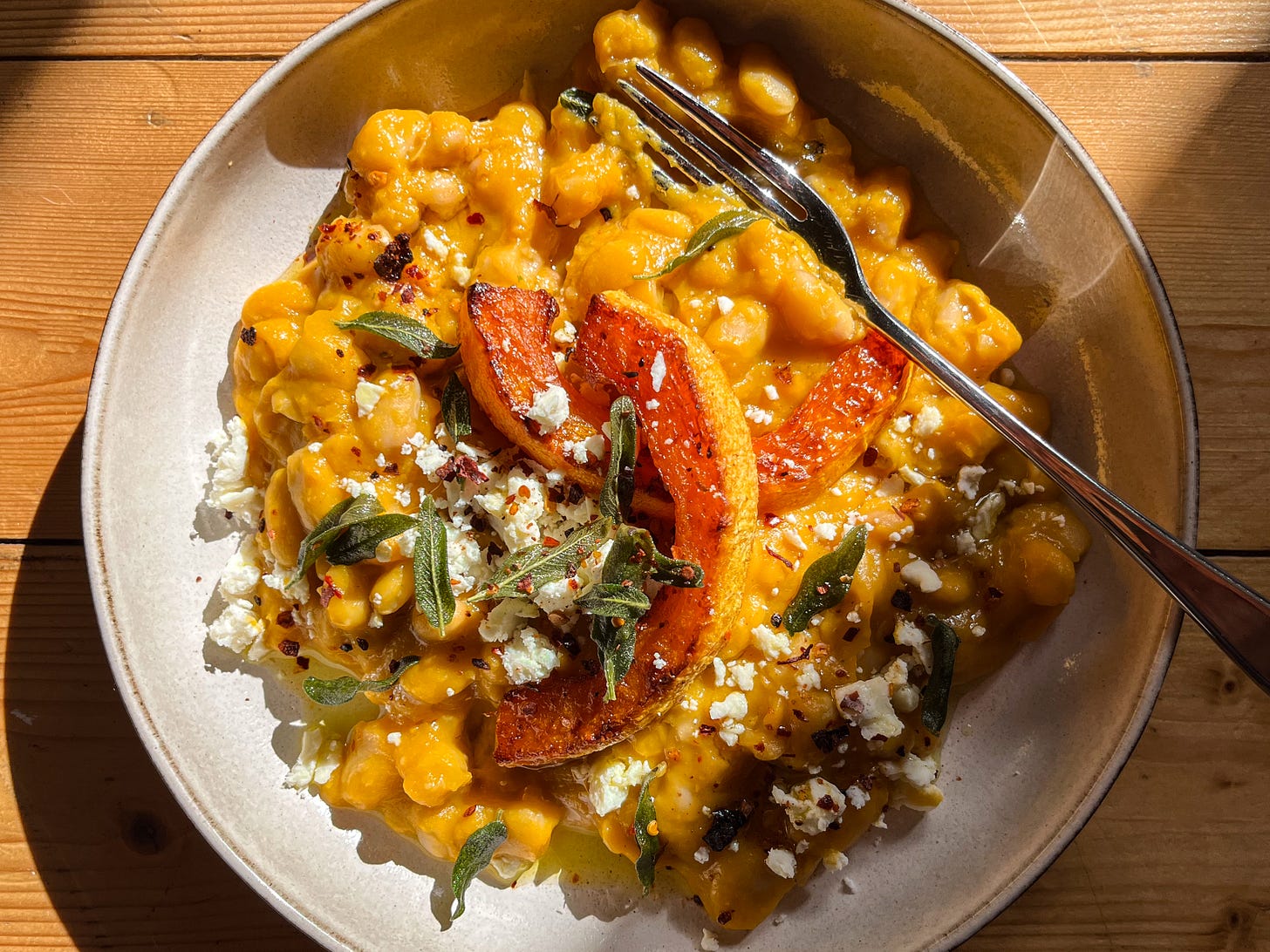Butternut Squash.
Autumn's ubiquitous squash. Plus, a recipe for Butternut Beans with Crispy Sage & Ricotta Salata.
Welcome to ingredient, where every so often I take a deep dive into some of my favourite seasonal and store cupboard ingredients. Today I’m focusing on Butternut Squash: *the* squash of autumn which really does deserve it’s dominance.
At the bottom of this post you’ll find my recipe for my wonderfully creamy Butternut Squash Beans with Crispy Sage and Ricotta Salata. Yes, I’ve written yet another recipe for jarred beans (it’s chicken up next, with not a bean in sight, promise!) White beans, like baked beans, are enveloped in a creamy, dairy-free roasted butternut squash and garlic sauce (which also works beautifully with pasta, gnocchi or stirred into risotto) before being topped with salty ricotta salata and my favourite autumnal garnish, crispy sage. Delicious by themselves, or on toast.
To access this subscriber-only recipe, as well as the rest of the ingredient recipe archive (now the colder weather is arriving can I point you in the direction of my Lebanese-inspired Chickpea and Lentil Soup, my Wild Venison Osso Bucco with Risotto Milanese or my Parsnip Gnocchi with Pancetta & Crispy Sage?) do upgrade your subscription or become a subscriber below!
Butternut Squash is the everyman’s squash. Except perhaps the pumpkin, which to my great frustration usually gets carved or baked with rather than cooked, when someone thinks squash for autumn, they think the long necked, bulbous bottomed, vibrantly orange butternut.
A cross between a pumpkin and a gooseneck winter squash first developed in 1940’s Massachusetts, I think in recent years the sweet, vegetal butternut has been unfairly put aside in favour of more ‘interesting’ ‘heirloom’ varieties. But honestly, with it’s mild, smooth, winter-squash flavour I find it’s the perfect blank canvas because it does not have the distinct flavour and texture, say, of a Crown Prince, meaning that it’s perfect for all sorts of seasonal soups, roasts and sauces: it will compliment, rather than compete with the flavours you’re pairing it with.
If you’re a gardener, they’re also both easy and rather satisfying to grow from seed, with or without a greenhouse or cold frame to help your seedlings along.
One of my favourite books for digging into the essence of an ingredient, The Flavour Thesaurus is helpful in putting your finger on the biggest culinary differences between the pumpkin and the butternut:
Butternut squash and pumpkins share a chapter as they have similar flavour affinities and are often used interchangeably. Bear in mind, though, that butternut squash is naturally sweeter and will need less sugar in sweet recipes. There’s also a difference in texture: the dense flesh of butternut squash is fine-grained and silky, whereas pumpkin can be rather fibrous. The pronounced sweetness of butternut squash works well with salty ingredients; cut through with something spikily sour, or, in combination with the density of its flesh, as a background for potent herbs such as rosemary or sage.
What I love about the above extract is it’s focus on texture, and why as a British cook butternut is always what I reach for when I’m looking to create a silky autumnal sauce: for us, it blends up better as we simply don’t have canned pumpkin to hand unless we’ve ordered a can to try our hand at making an American pie, the way American recipe writers always have a few cans to hand as we approach Thanksgiving.
In my own kitchen, I’m unashamed that unless I want a squash or a pumpkin for a certain texture or visual exercise, it will always be the butternut I buy. Sage (preferably crispy), fatty, crisped pieces of bacon, toasted almonds or hazelnuts, chilli, lime, fresh ginger and rosemary from the garden are all flavours I reach for as accents, as well as sharp, salty cheeses such as pecorino, feta and parmesan. If you’ve got any end-of-season greenhouse tomatoes hanging around butternut makes a great base note for a Slow Roasted Tomato and Squash Soup, and it also works well layered into gratins and tarts for entertaining like my Butternut Squash, Parmesan & Sage Tart. And let us not forget one of my favourite recipes in One Pan Pescatarian (and a real reader favourite too), my Creamy Butternut Squash Risotto, reprinted by Stylist which pairs grated and cubed squash with tender rice for a lesson in how texture can also impact flavour.
Elsewhere, I have so many recipes bookmarked for my butternuts I’m excited to finally be not travelling again this year so that I’ll finally have time to tackle some of them during my kitchen downtime.
posted a recipe for Marinated Squash with White Beans and Tarragon last winter I’m still thinking about, the Roasted Squash with Porcini Cream (pg 90) in Diana Henry’s reissued Roast Figs, Sugar Snow sounds both simple and luxurious, and I think this is the year that I’m finally going to whip up a batch of ’s Tipsy Amaretto Squash Soup (complete with a garnish of crumbled amaretti biscuits - pg 89) from her exceptional memoir-meets-cookbook Midnight Chicken. All hopefully excellent examples of how simple methods and clever flavour pairings really make butternut sing.Butternut Squash Beans with Crispy Sage & Ricotta Salata
Serves: 2, Preparation time: 15 minutes, Cooking time: 55 minutes
These luxuriously creamy Butternut Beans are an autumnal take on baked beans - delicious as a side dish, on toast or on their own with the essential toppings of crispy sage and ricotta salata, which, if you’ve not had it before is an aged, firm ricotta with a flavour like parmesan or pecorino which still retains some of ricotta’s creamy depths, whilst having a texture similar to a very firm feta, great for crumbling or grating. If you can’t find it, feta would be a good substitute here, or shavings of either of the aforementioned hard cheeses. I buy mine from Natoora on Ocado.
400g butternut squash










